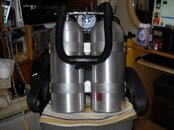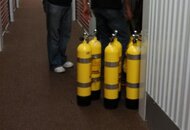GrumpyOldGuy
Contributor
How deep do you dive? Double 50's sounds like a ridiculous solution to me... If you want to reduce gear, use the 100 steel and drop the pony down to even a 6 cu-ft tank.. That should get you from 100 to zero feet, with very little trouble and negligible weight and drag (and cheap too).
I did the LP 50's thing 30 years ago for commercial charter boat dives. They were fun to dive and I had free fills. But the overhead of dealing with doubles was not worthwhile on shore dives. Just a simple run of 2 shore dives required a run to the dive shop and loosing my parking spot. They were heavy hiking up the stairs after the dive and were high maintenance.
The wide spread availability of HP steel tanks now days makes for a cheaper, lighter, simpler system and swapping tanks is fast.






